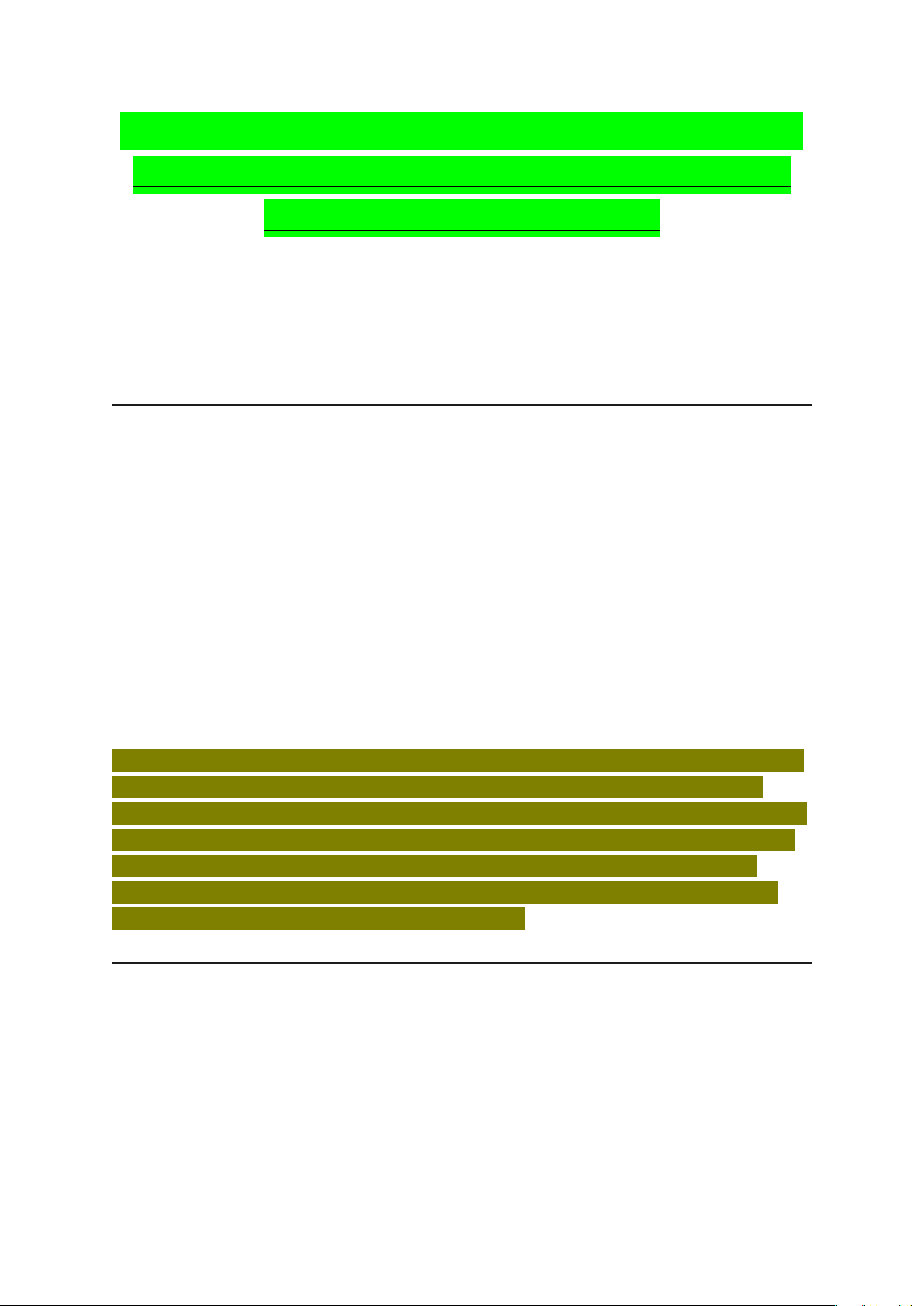
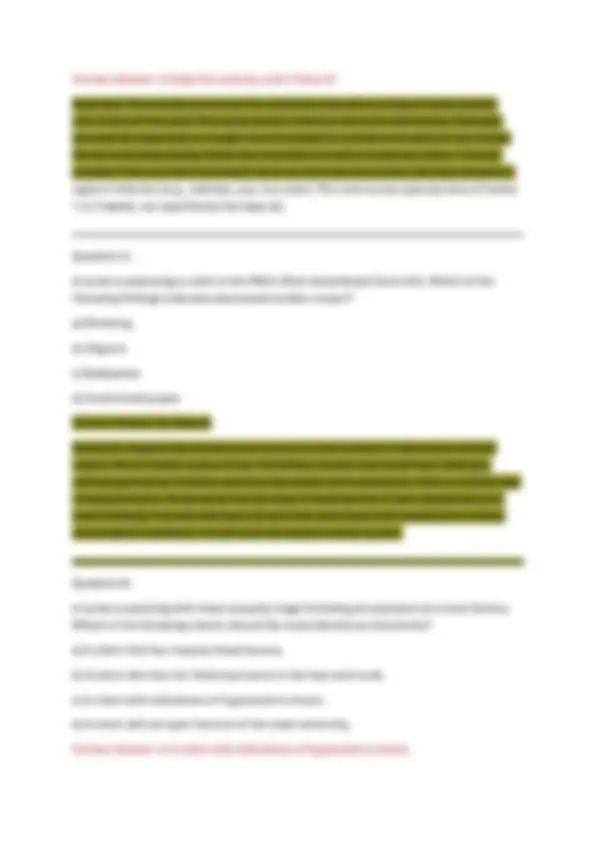
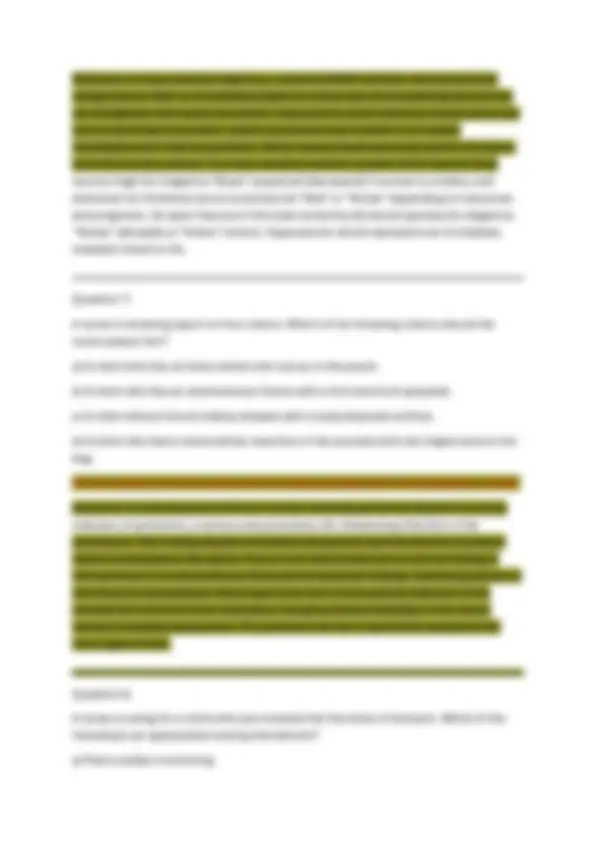
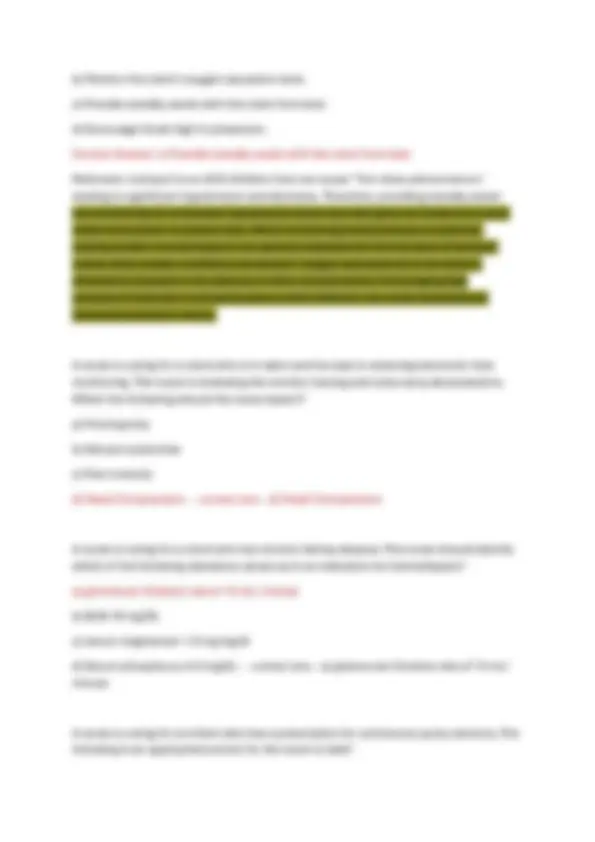
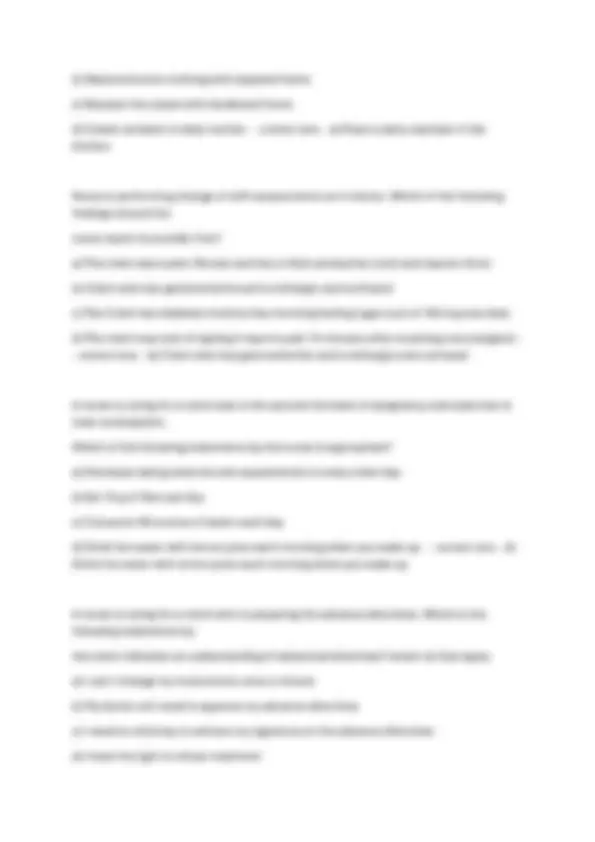
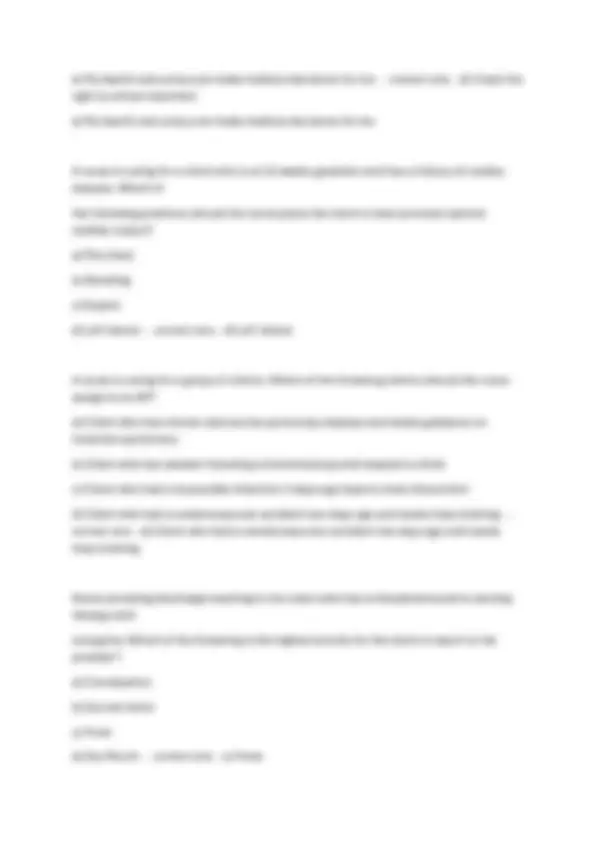
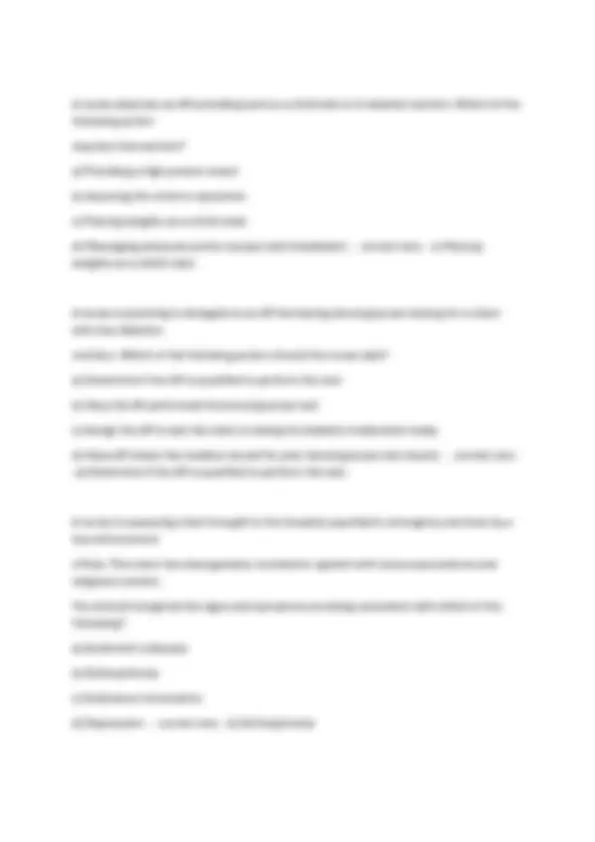
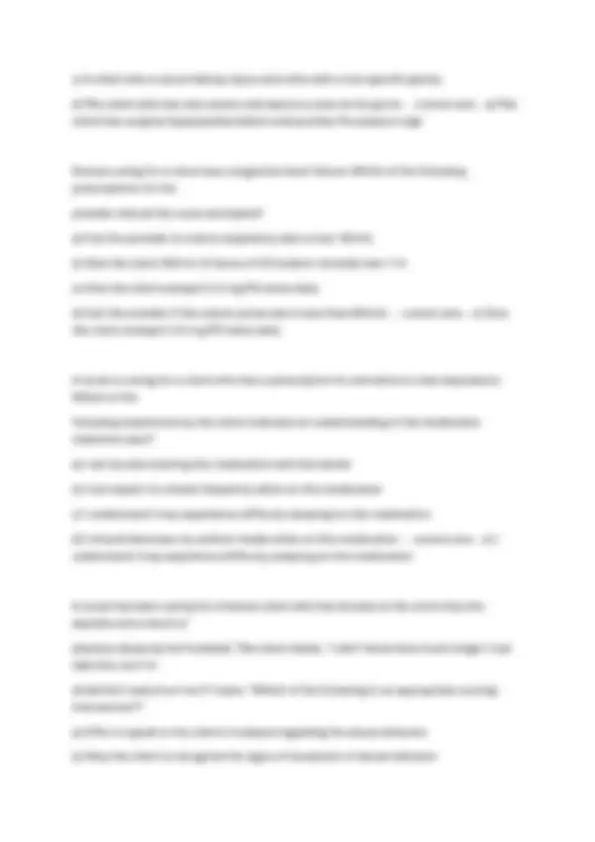
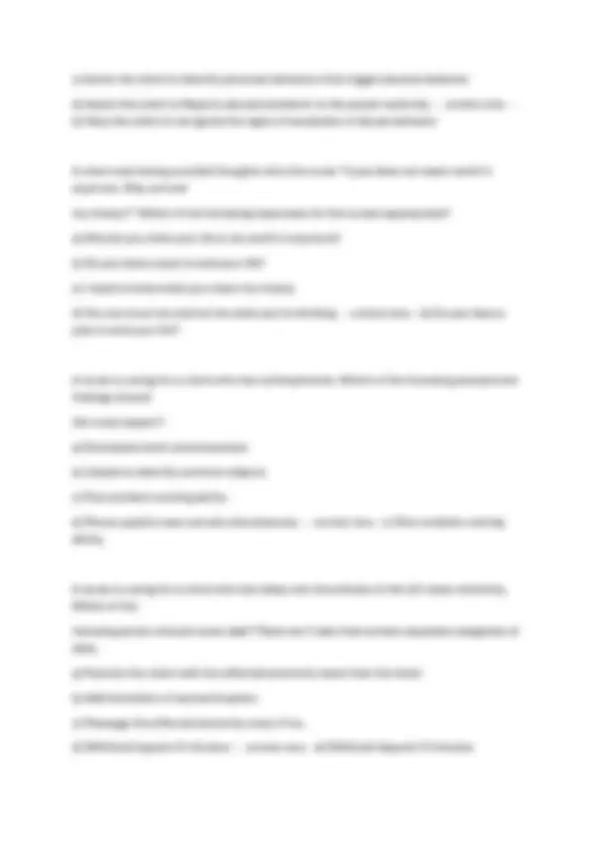
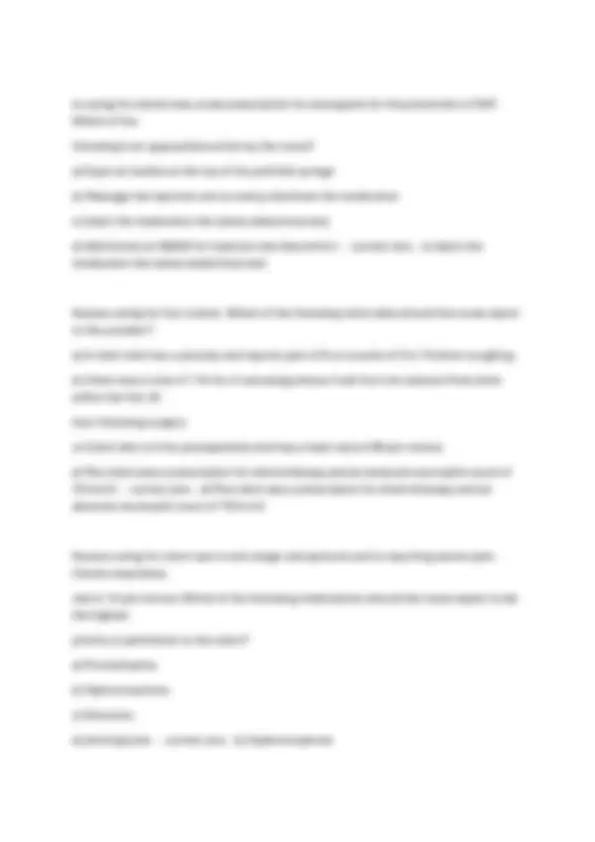
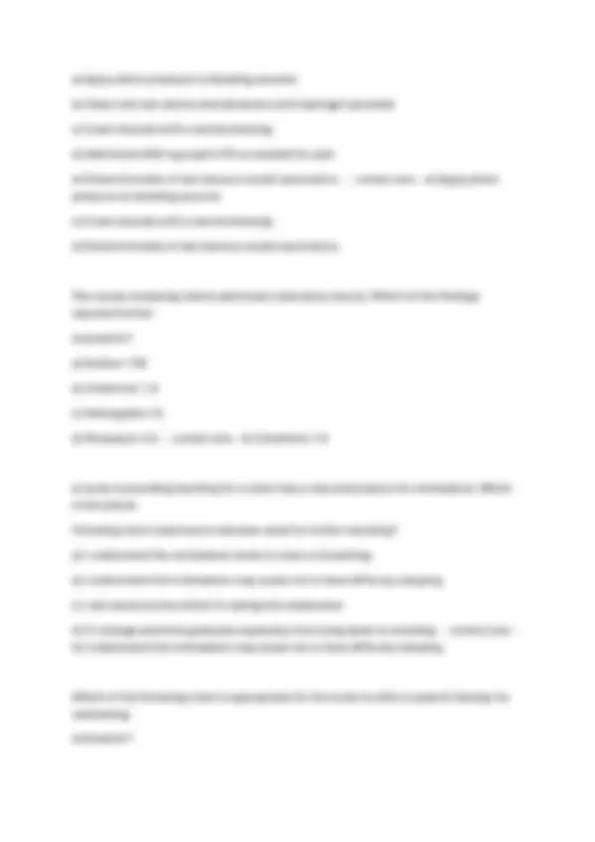
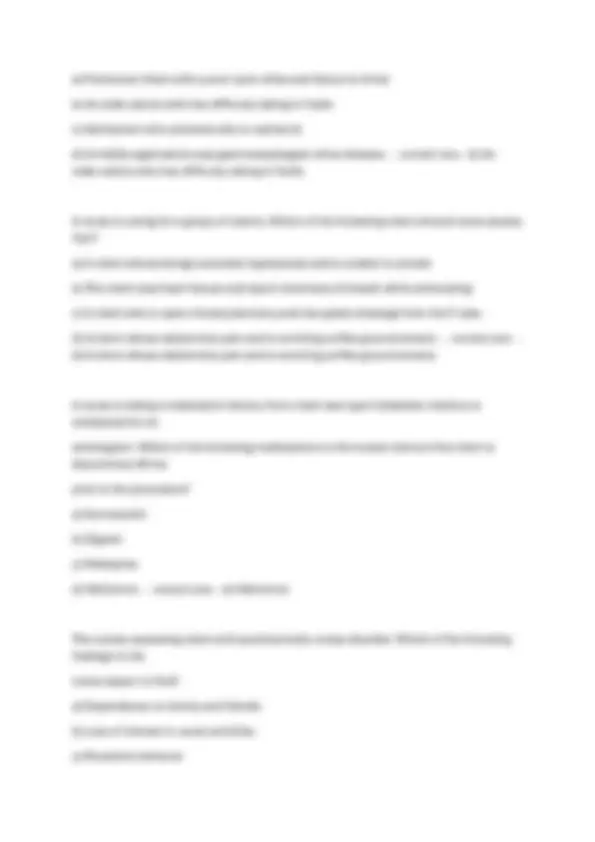
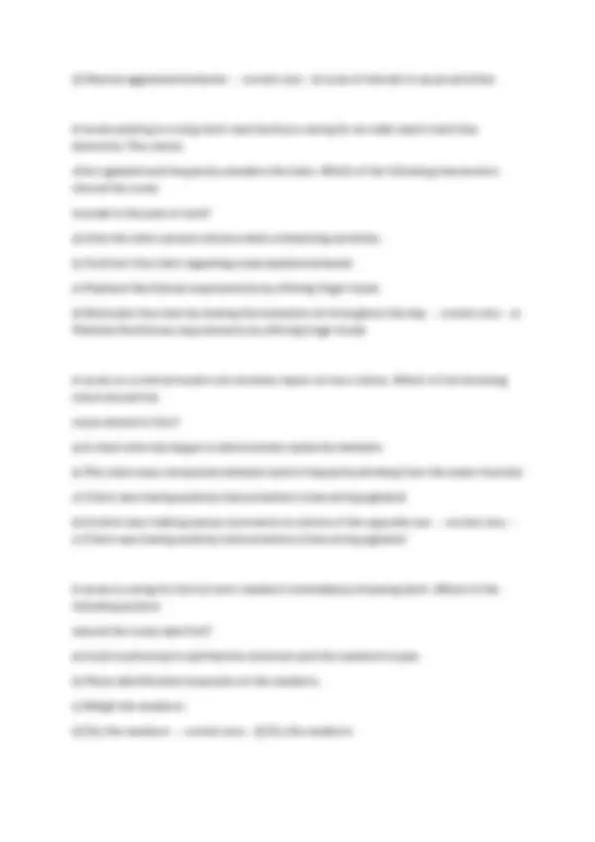
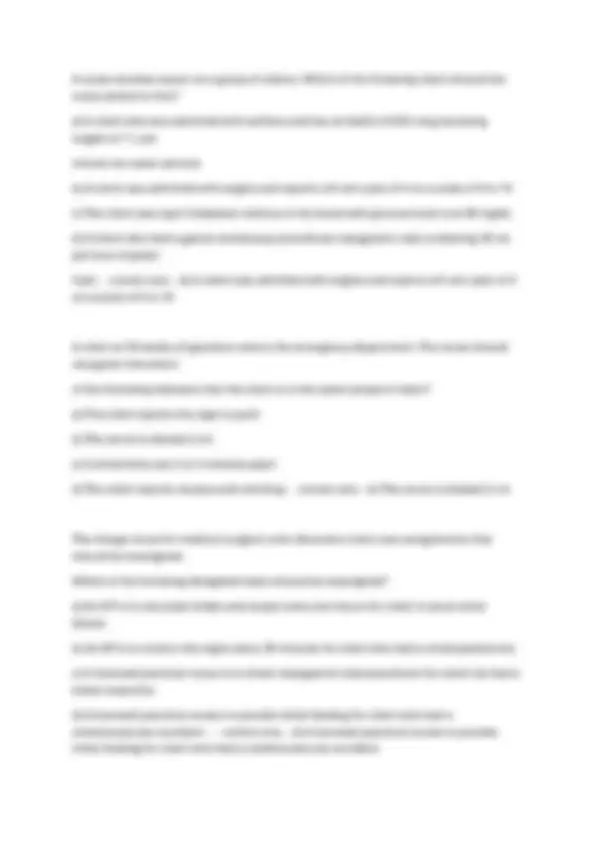
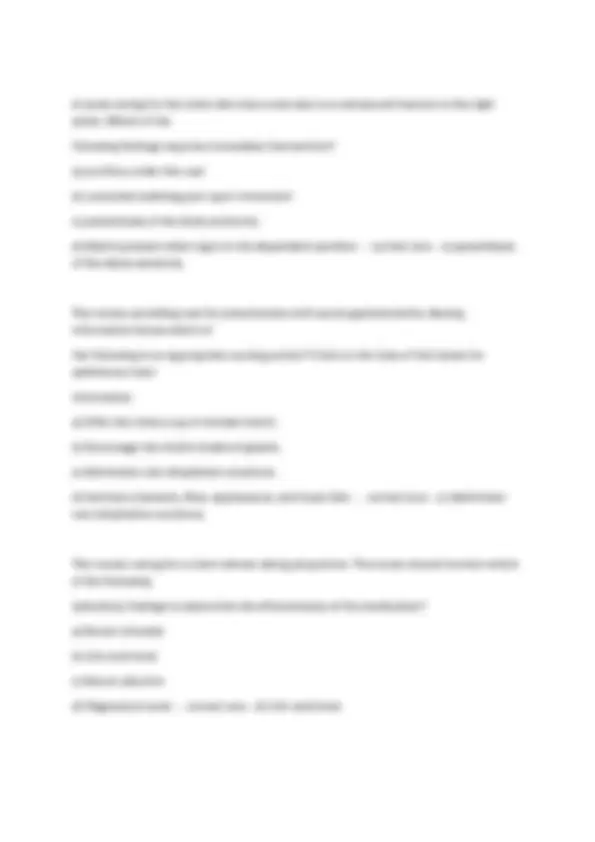
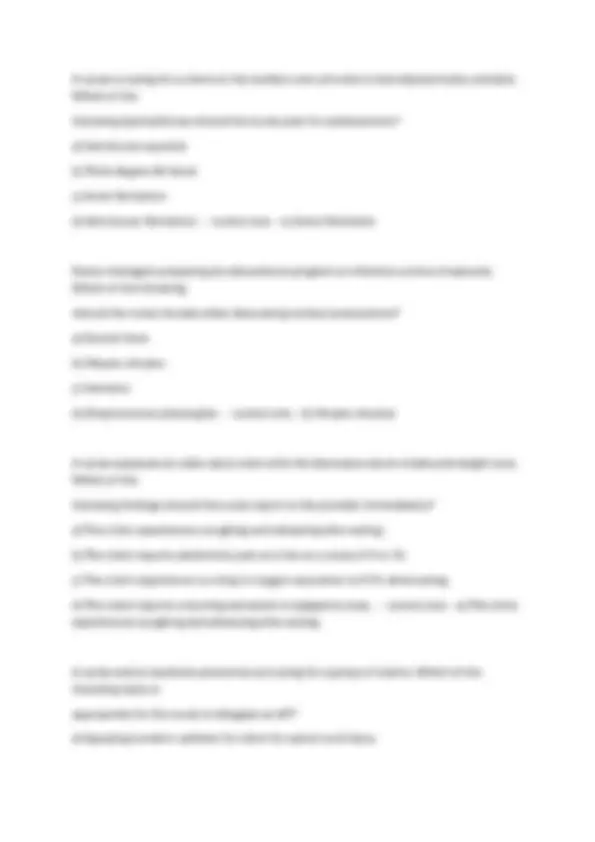
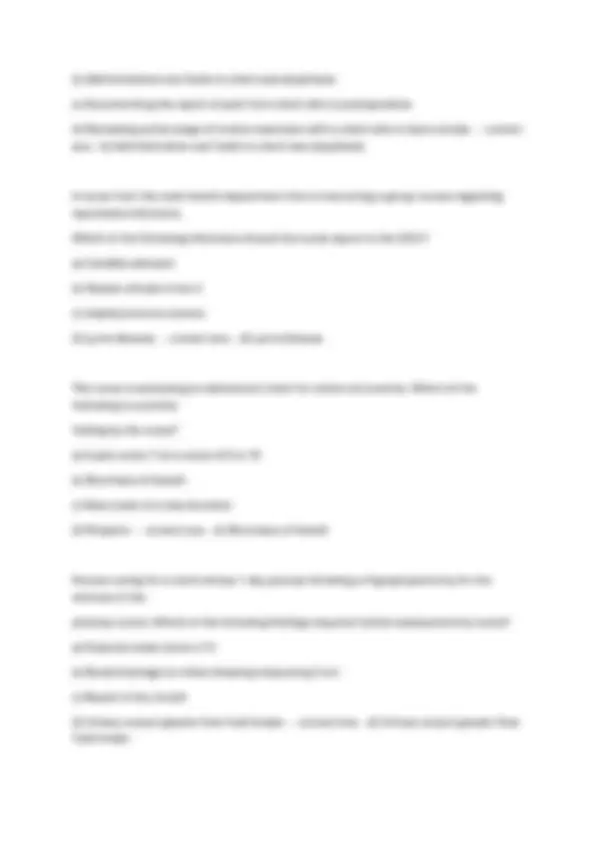
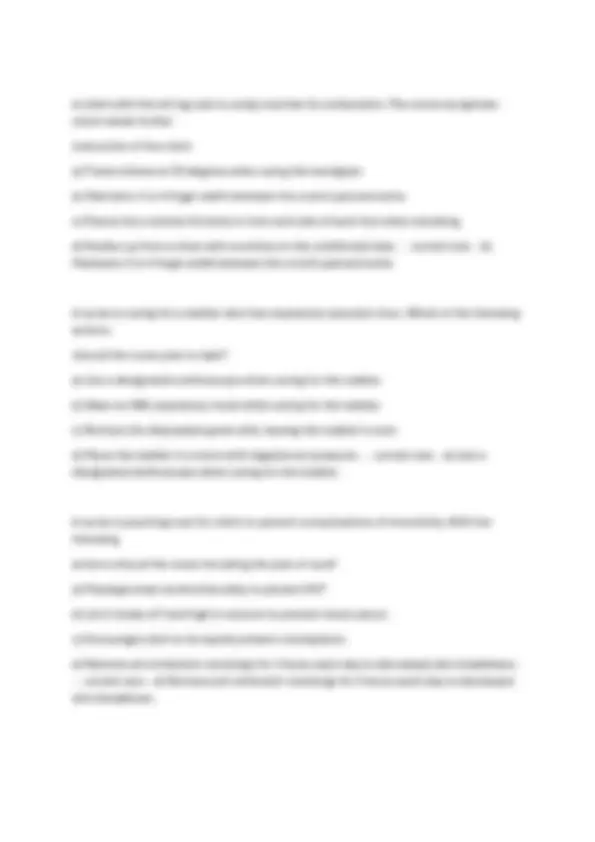
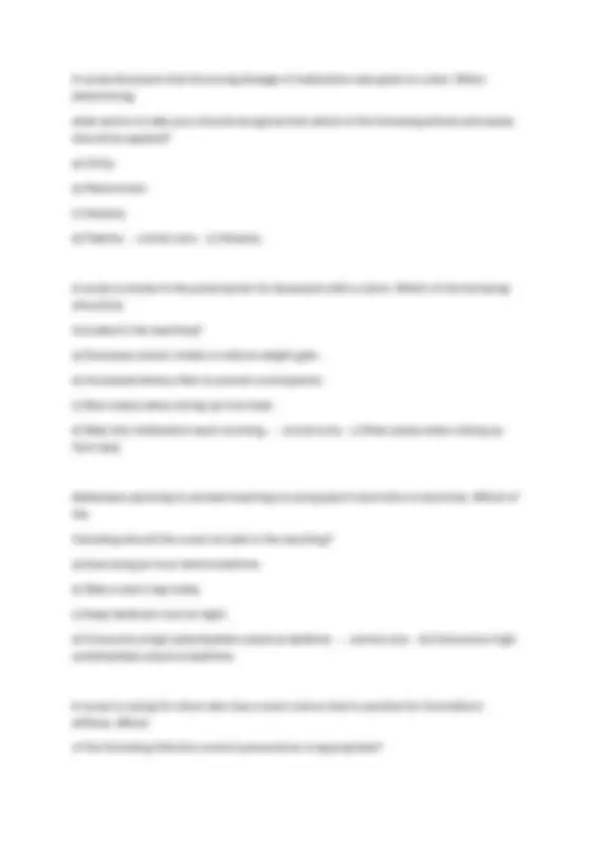
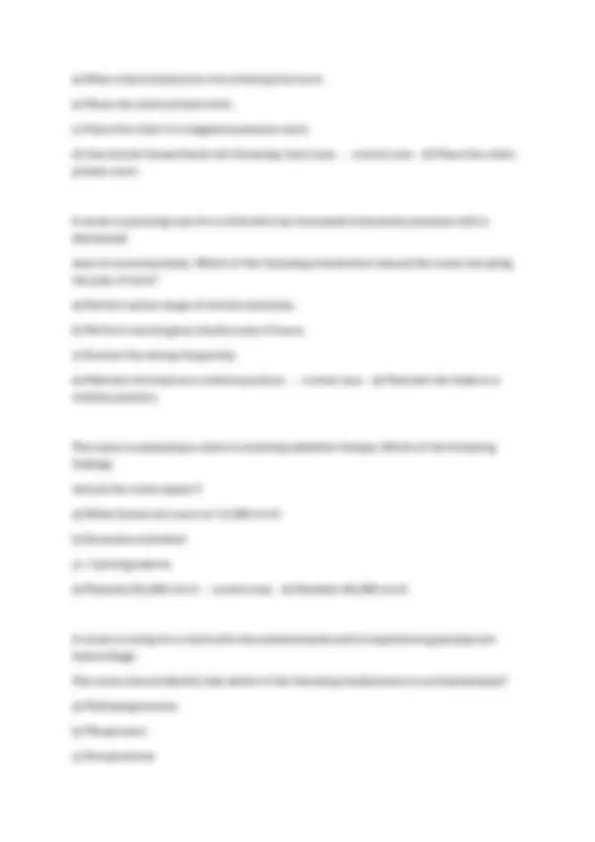
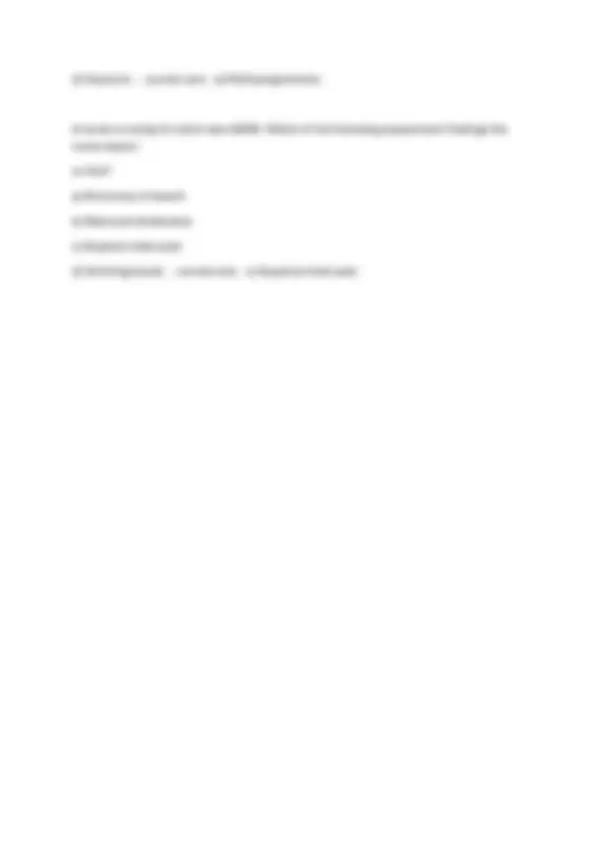


Study with the several resources on Docsity

Earn points by helping other students or get them with a premium plan


Prepare for your exams
Study with the several resources on Docsity

Earn points to download
Earn points by helping other students or get them with a premium plan
Community
Ask the community for help and clear up your study doubts
Discover the best universities in your country according to Docsity users
Free resources
Download our free guides on studying techniques, anxiety management strategies, and thesis advice from Docsity tutors
A.T.I Comprehensive Predictor Exam Review 2025: Expert Tips, High-Yield Practice Questions, and Ultimate NCLEX Prep Toolkit
Typology: Exams
1 / 28

This page cannot be seen from the preview
Don't miss anything!





















Here are multi-choice questions and rationales for each of the provided scenarios, with the correct answer indicated. Question 1: A nurse in an emergency department completes an assessment on an adolescent client that has conduct disorder. The client threatened suicide to a teacher at school. Which of the following statements should the nurse include in the assessment? a) Tell me about your siblings. b) Tell me what kind of music you like. c) Tell me how often do you drink alcohol. d) Tell me about your school schedule. Correct Answer: c) Tell me how often do you drink alcohol. Rationale: When assessing an adolescent with conduct disorder and a suicide threat, it is crucial to inquire about risk factors that could increase the likelihood of suicidal ideation or attempts. Substance abuse, including alcohol use, is a significant risk factor for suicide in adolescents, especially those with co-occurring mental health disorders like conduct disorder. While other options might be part of a general assessment, assessing substance use directly addresses a high-priority risk factor in this specific scenario to determine the client's immediate safety. Question 2: A nurse is observing bonding between a client and her newborn. Which of the following actions by the client requires the nurse to intervene? a) Holding the newborn in an en face position. b) Asking the father to change the newborn's diaper. c) Requesting the nurse take the newborn to the nursery so she can rest.
d) Viewing the newborn's actions to be uncooperative. Correct Answer: d) Viewing the newborn's actions to be uncooperative. Rationale: Option (d) indicates a potential problem with maternal-infant bonding. Perceiving the newborn as "uncooperative" suggests a negative perception or lack of emotional connection that can hinder the development of a healthy attachment. Options (a), (b), and (c) are all normal and healthy behaviors. Holding the newborn in an en face position promotes eye contact and bonding. Asking the father to change a diaper demonstrates shared parenting and support. Requesting rest is a normal and often necessary part of postpartum recovery. Question 3: A nurse is caring for a client who is taking levothyroxine. Which of the following findings should indicate that the medication is effective? a) Weight loss b) Decreased blood pressure c) Absence of seizures d) Decreased inflammation Correct Answer: a) Weight loss Rationale: Levothyroxine is a thyroid hormone replacement medication used to treat hypothyroidism. Hypothyroidism often causes a slowed metabolism, leading to symptoms such as weight gain, fatigue, cold intolerance, and constipation. Effective treatment with levothyroxine will increase metabolism, often resulting in weight loss, increased energy, and resolution of other hypothyroid symptoms. Options (b), (c), and (d) are not direct indicators of levothyroxine effectiveness for hypothyroidism. Question 4: A nurse is planning discharge teaching for cord care for the parent of a newborn. Which instruction would you include in the teaching? a) Contact provider if the cord still turns black. b) Clean the base of the cord with hydrogen peroxide daily. c) Keep the cord dry until it falls off. d) The cord stump will fall off in five days.
Rationale: In mass casualty triage (e.g., using the START method), the priority (often categorized as "Red" or immediate) is given to clients with life-threatening injuries that are salvageable with rapid intervention. Hypovolemic shock indicates severe blood loss and compromised circulation, which can quickly lead to death if not treated immediately with fluid resuscitation. While massive head trauma (a) and full-thickness burns (b) are very serious, in a mass casualty scenario, a patient with massive head trauma might be triaged as "Black" (expectant/deceased) if survival is unlikely, and extensive full-thickness burns could also be "Red" or "Yellow" depending on resources and prognosis. An open fracture of the lower extremity (d) would typically be triaged as "Yellow" (delayed) or "Green" (minor). Hypovolemic shock represents an immediate, treatable threat to life. Question 7: A nurse is receiving report on four clients. Which of the following clients should the nurse assess first? a) A client who has an ileal conduit and mucus in the pouch. b) A client who has an arteriovenous fistula with a thrill and bruit palpated. c) A client whose chronic kidney disease with cloudy dialysate outflow. d) A client who had a transurethral resection of the prostate with red-tinged urine in the bag. Correct Answer: c) A client whose chronic kidney disease with cloudy dialysate outflow. Rationale: Cloudy dialysate outflow in a client receiving peritoneal dialysis is a strong indicator of peritonitis, a serious and potentially life-threatening infection of the peritoneum. This finding requires immediate assessment and intervention to prevent severe complications like sepsis. Mucus in an ileal conduit (a) is a normal finding. A thrill and bruit in an arteriovenous fistula (b) are expected findings, indicating patency of the fistula for hemodialysis. Red-tinged urine after a transurethral resection of the prostate (d) is common post-procedure, though excessive bleeding or clots would warrant immediate assessment. The potential infection of peritonitis represents the most urgent threat. Question 8: A nurse is caring for a client who just received the first dose of lisinopril. Which of the following is an appropriate nursing intervention? a) Place cardiac monitoring.
b) Monitor the client's oxygen saturation level. c) Provide standby assist with the client from bed. d) Encourage foods high in potassium. Correct Answer: c) Provide standby assist with the client from bed. Rationale: Lisinopril is an ACE inhibitor that can cause "first-dose phenomenon," leading to significant hypotension and dizziness. Therefore, providing standby assist and monitoring for orthostatic hypotension when the client gets out of bed is a crucial safety intervention to prevent falls. While monitoring blood pressure is essential, placing cardiac monitoring (a) is not typically indicated for the first dose of lisinopril unless other cardiac conditions are present. Oxygen saturation (b) is not directly affected by lisinopril in the absence of other complications. Encouraging high potassium foods (d) is contraindicated as ACE inhibitors can cause hyperkalemia (elevated potassium levels). A nurse is caring for a client who is in labor and his seat is receiving electronic fetal monitoring. The nurse is reviewing the monitor tracing and notes early decelerations. Which the following should the nurse expect? a) Feta hypoxia b) Abrupto placentae c) Post maturity d) Head Compression - - correct ans- - d) Head Compression A nurse is caring for a client who has chronic kidney disease. The nurse should identify which of the following laboratory values as in an indication for hemodialysis? a) glomerular filtration rate of 14 mL/ minute b) BUN 16 mg/DL c) serum magnesium 1.8 mg mg/dl d) Serum phosphorus 4.0 mg/dL - - correct ans- - a) glomerular filtration rate of 14 mL/ minute A nurse is caring for an infant who has a prescription for continuous pulse oximetry. The following is an appropriate action for the nurse to take?
A nurse is obtaining the medical history of a client who has a new prescription for isosorbide monotitrate. Which of the following should the nurse identify as a contraindication to medication? a) Glaucoma b) Hypertension c) Polycythemia d) Migraine headaches - - correct ans- - a) Glaucoma The nurses is caring for a client recovering from an acute myocardial infarction. Which following intervention should the nurse include in the point of care? a) Draw a troponin level every four hours b) Performance EKG every 12 hours c) Plant oxygen tent fell over minutes via rebreather mask d) Obtain a cardiac rehabilitation consult - - correct ans- - d) Obtain a cardiac rehabilitation consult A Nurses caring for client who has breast cancer and has been covering receiving chemotherapy. Which of the following laboratory values should nurse report to provider? a) WBC 3,000/mm b) Hemoglobin 14 g/dl c) Platelet 250,000/mm d) aPTT 30 seconds - - correct ans- - a) WBC 3,000/mm Home health nurse is carefully planned for Alzheimer's disease. To the following action should the nurse include in the plan of care a) Place a daily calendar in the kitchen
b) Replace button clothing with zippered items c) Replace the carpet with hardwood floors d) Create variation in daily routine - - correct ans- - a) Place a daily calendar in the kitchen Nurse is performing change of shift assessments on 4 clients. Which of the following findings should the nurse report to provider first? a) The client was cystic fibrosis and has a thick productive clock and reports thirst b) Client who has gastroenteritis and is lethargic and confused c) The Client has diabetes mellitus has morning fasting Legal cost of 185 mg over deal d) The client was sick of signing it reports pain 15 minutes after receiving oral analgesic -
A nurse observes an AP providing care to a child who is in skeletal traction. Which of the following action requires intervention? a) Providing a high protein snack b) Assisting the child to reposition c) Placing weights as a child's bed d) Massaging pressure points-causes skin breakdown - - correct ans- - c) Placing weights as a child's bed A nurse is planning to delegate to an AP the fasting blood glucose testing for a client who has diabetes mellitus. Which of the following action should the nurse take? a) Determine if the AP is qualified to perform the test. b) Help the AP performed the blood glucose test c) Assign the AP to ask the client is taking his diabetic medication today d) Have AP check the medical record for prior blood glucose test results - - correct ans-
A nurse is caring for a child who has infectious mononucleosis.. Which of the following findings are associated with this diagnosis? Select all that apply a) splenomegaly b) Koplik spots c) Malaise d) Vertigo e) Sore throat - - correct ans- - a) splenomegaly c) Malaise e) Sore throat Nurse is performing dressing change for client was a sacral wound using negative pressure wound therapy. Which The following actions should the nurse take first? a) Apply skin preparation to wound edges. b) Normal saline c) Don sterile gloves d) Determine pain level - - correct ans- - d) Determine pain level A nurses caring for client recovery from the bowel surgery who has nasogastric tube connected to low intermittent suction. Which the following assessment findings should indicate to the nurse that the NG tube may not be functioning properly? a) Drainage fluid is greenish-yellow b) aspirate pH of 3 c) Abdominal rigidity d) air bubbles noted in the NG tube - - correct ans- - c) Abdominal rigidity
c) A client who is acute kidney injury and urine with a low specific gravity d) The client who has oral cancer and reports a sore on his gums - - correct ans- - a) The client has surgical hypoparathyroidism and positive Trousseau's sign Nurses caring for a client was congestive heart failure. Which of the following prescriptions for the provider should the nurse anticipate? a) Call the provider to clients respiratory rate is less 18/min b) Give the client 500 mL IV bolus of 0.9 sodium chloride over 1 hr c) Give the client enalapril 2.5 mg PO twice daily d) Call the provider if the clients pulse rate is less than 80/min - - correct ans- - c) Give the client enalapril 2.5 mg PO twice daily A nurse is caring for a client who has a prescription for sertraline to treat depression. Which of the following statements by the client indicates an understanding of the medication treatment plan? a) I will be able starting this medication with feel better b) I can expect to urinate frequently while on this medication c) I understand I may experience difficulty sleeping on this medication d) I should decrease my sodium intake while on this medication - - correct ans- - c) I understand I may experience difficulty sleeping on this medication A nurse has been caring for a female client who has bruises on her arms that she explains are a result of physical abuse by her husband. The client states, "I don't know how much longer I can take this, but I'm afraid he'll really hurt me if I leave. "Which of the following is an appropriate nursing intervention?" a) Offer to speak to the client's husband regarding his abuse behavior. b) Help the client to recognize the signs of escalation of abuse behavior
c) Assist the client to identify personal behaviors that trigger abusive behavior d) Assist the client to Reports abusive behavior to the proper authority - - correct ans- - b) Help the client to recognize the signs of escalation of abuse behavior A client was having suicidal thoughts tells the nurse "It just does not seem worth it anymore. Why not end my misery?" Which of the following responses for the nurses appropriate? a) Why do you think your life is not worth it anymore? b) Do you have a plan to end your life? c) I need to know what you mean my misery d) You can trust me and tell me what you're thinking - - correct ans- - b) Do you have a plan to end your life? A nurse is caring for a client who has schizophrenia. Which of the following assessment findings should the nurse expect? a) Decreased level consciousness b) Unable to identify common objects c) Poor problem solving ability d) Preoccupation was somatic disturbances - - correct ans- - c) Poor problem solving ability A nurse is caring for a client who has deep vein thrombosis of the left lower extremity. Which of the following action should nurse take? There are 3 tabs that contain separate categories of data. a) Position the client with the affected extremity lower than the heart b) Administration of acetaminophen c) Massage the affected extremity every 4 hrs. d) Withhold heparin IV infusion - - correct ans- - d) Withhold heparin IV infusion
A nurse is caring for a client who has DVT. Which of the following instructions the nurse include in the plan of care? a) Live with the clients fluid intake to 1500 mL per day b) Massage place affected extremity to relieve pain c) Apply cold packs of clients affected extremity d) Elevate the client's affected extremity when in bed - - correct ans- - d) Elevate the client's affected extremity when in bed A nurse is caring for a client who is receiving oxytocin IV for augmentation of labor. The client's contractions are occurring every 45 seconds with a nine seconds duration in the fetal heart rate is 170 to 180/minute. Which of the following actions should nurse take? a) Discontinue oxytocin infusion b) Increased oxytocin infusion c) Decreased oxytocin infusion d) Maintain oxytocin infusion - - correct ans- - a) Discontinue oxytocin infusion A nurse is admitting a client who is in labor and at 38 wks of gestation to the maternal newborn unit. The client has a history of herpes simplex virus 2. Which of the following questions is most appropriate for the nurse to ask the client? a) Have your membranes ruptured? b) How far apart are your contractions? c) Do you have any active lesions? d) Are you positive for beta strap? - - correct ans- - c) Do you have any active lesions?
Nurse is providing teaching for child prescribed ferrous sulfate. Which of the following instructions should the nurse include? a) Take with meals b) Take at bedtime c) Take with a glass of milk d) Take with a glass of orange juice - - correct ans- - d) Take with a glass of orange juice Four clients present to the emergency department. The nurse should plan to see which of the following clients first? a) A 6 year old client whose left shoulder is dislocated b) A 26 year old client for sickle cell disease and a severe joint pain c) A 76 year old client was confused, febrile and has foul smelling urine d) A 50- year old client who has slurred speech, is disoriented, and reports a headache -
a) Premature infant with a poor suck reflex and failure to thrive b) An older adults who has difficulty taking in fluids c) Adolescent who anorexia who is cachectic d) A middle aged adults was gastroesophageal reflux disease - - correct ans- - b) An older adults who has difficulty taking in fluids A nurse is caring for a group of clients. Which of the following client should nurse assess first? a) A client whose benign prostatic hyperplasia and is unable to urinate b) The client was heart failure and report shortness of breath while ambulating c) A client who is open cholecystectomy and has green drainage from the T-tube d) A client whose abdominal pain and is vomiting coffee ground emesis - - correct ans- - d) A client whose abdominal pain and is vomiting coffee ground emesis A nurse is taking a medication history from client was type II diabetes mellitus is scheduled for an arteriogram. Which of the following medications to the nurses instruct the client to discontinue 48 hrs prior to the procedure? a) Atorvastatin b) Digoxin c) Nifedipine d) Metformin - - correct ans- - d) Metformin The nurses assessing client with posttraumatic stress disorder. Which of the following findings to the nurse expect to find? a) Dependence on family and friends b) Loss of interest in usual activities c) Ritualistic behavior
d) Passive aggressive behavior - - correct ans- - b) Loss of interest in usual activities A nurse working in a long-term care facility is caring for an older adult client has dementia. The clients often agitated and frequently wanders the halls. Which of the following intervention should the nurse include in the plan of care? a) Give the client several choices when scheduling activities. b) Confront the client regarding unacceptable behavior c) Maintain Nutritional requirements by offering finger foods d) Stimulate the client by leaving the television on throughout the day - - correct ans- - c) Maintain Nutritional requirements by offering finger foods A nurse on a mental health unit receives report on four clients. Which of the following client should the nurse attend to first? a) A client who has begun to demonstrate catatonic behavior b) The client was compulsive behavior and is frequently drinking from the water fountain c) Client was having auditory hallucinations is becoming agitated d) A client was making sexual comments to clients of the opposite sex - - correct ans- - c) Client was having auditory hallucinations is becoming agitated A nurse is caring for the full term newborn immediately following birth. Which of the following actions should the nurse take first? a) Instill erythromycin ophthalmic ointment and the newborn's eyes. b) Place identification bracelets on the newborn. c) Weigh the newborn. d) Dry the newborn - - correct ans- - d) Dry the newborn